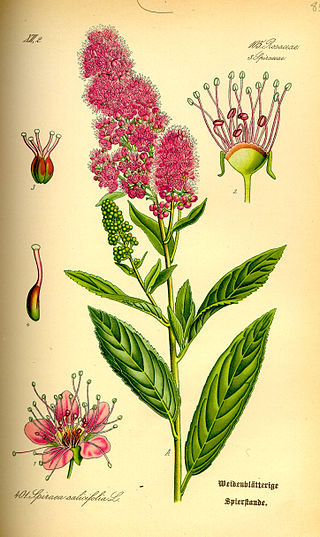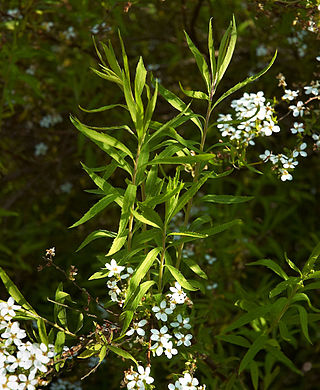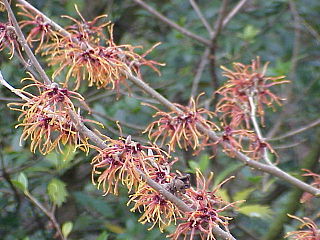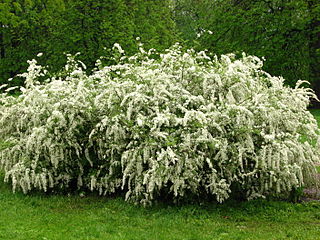
Hibiscus syriacus is a species of flowering plant in the mallow family, Malvaceae. It is native to south-central and southeast China, but widely introduced elsewhere, including much of Asia, both in the east and the west. It was given the epithet syriacus because it had been collected from gardens in Syria. Common names include the rose of Sharon,, Syrian ketmia, shrub althea, and rose mallow. It is the national flower of South Korea and is mentioned in the South Korean national anthem.

Pieris is a genus of seven species of shrubs in the flowering plant family Ericaceae, native to mountain regions of eastern and southern Asia, eastern North America and Cuba. Known commonly in North America as andromedas or fetterbushes, they are broad-leaved evergreen shrubs growing to 1–6 metres tall and 3–10 ft (0.9–3.0 m) wide. The leaves are spirally arranged, often appearing to be in whorls at the end of each shoot with bare stretches of shoot below; they are lanceolate-ovate, 2–10 cm (0.8–3.9 in) long and 1.0–3.5 cm (0.4–1.4 in) broad, leathery textured, and with an entire or serrated margin. The young leaves in spring are typically brightly coloured. The flowers are bell-shaped, 5–15 mm (0.2–0.6 in) long, white or pink, and arranged in racemes 5–12 cm (2.0–4.7 in) long. The fruit is a woody capsule which splits into five sections to release the numerous small seeds.

Spiraea, sometimes spelled spirea in common names, and commonly known as meadowsweets or steeplebushes, is a genus of about 80 to 100 species of shrubs in the family Rosaceae. They are native to the temperate Northern Hemisphere, with the greatest diversity in eastern Asia.

Weigela is a genus of between six and 38 species of deciduous shrubs in the family Caprifoliaceae, growing to 1–5 m (3–15′) tall. All are natives of eastern Asia. The genus is named after the German scientist Christian Ehrenfried Weigel.

Kerria japonica, commonly known as Japanese kerria or Japanese rose, is a deciduous, yellow-flowering shrub in the rose family (Rosaceae), native to China, Japan and Korea. It is the only species in the genus Kerria. In the wild, it grows in thickets on mountain slopes. Japanese kerria has been used for medicine and is also planted in gardens. A double-flowered cultivar, K. japonica 'Pleniflora', is commonly called bachelor's buttons.

Lavandula angustifolia, formerly L. officinalis, is a flowering plant in the family Lamiaceae, native to the Mediterranean. Its common names include lavender, true lavender and English lavender ; also garden lavender, common lavender and narrow-leaved lavender.

Cornus alba, the red-barked, white or Siberian dogwood, is a species of flowering plant in the family Cornaceae, native to Siberia, northern China and Korea. It is a large deciduous surculose (suckering) shrub that can be grown as a small tree. As a popular ornamental used in landscaping its notable features include the red stems in fall (autumn) through late winter, bright winter bark; and the variegated foliage in some cultivars, such as C. alba 'Elegantissima'. C. alba can grow to 3 m (10 ft) high, but variegated forms are less vigorous. For the brightest winter bark, young shoots are encouraged by cutting to the ground some older stems at the end of the winter, before leaves are open. The oval fruits are white, sometimes tinted blue.

Fatsia japonica, also fatsi, paperplant, false castor oil plant, or Japanese aralia, is a species of flowering plant in the family Araliaceae, native to southern Japan and southern Korea.

Euonymus fortunei, the spindle, Fortune's spindle, winter creeper or wintercreeper, is a species of flowering plant in the family Celastraceae, native to east Asia, including China, Korea, the Philippines and Japan. E. fortunei is highly invasive and damaging in the United States, causing the death of trees and forest in urban areas.

Physocarpus opulifolius, known as common ninebark, Eastern ninebark, Atlantic ninebark, or simply ninebark, is a species of flowering plant in the rose family Rosaceae, native to eastern North America.

Spiraea thunbergii (珍珠绣线菊), Thunberg spiraea or Thunberg's meadowsweet, is a species of flowering plant in the rose family, native to East China and Japan, and widely cultivated elsewhere.

Itea virginica, commonly known as Virginia willow or Virginia sweetspire, is a small North American flowering shrub that grows in low-lying woods and wetland margins. Virginia willow is a member of the Iteaceae family, and native to the southeast United States. Itea virginica has small flowers on pendulous racemes.

Pachysandra terminalis, the Japanese pachysandra, carpet box or Japanese spurge, is a species of flowering plant in the boxwood family Buxaceae, native to Japan, Korea and China and introduced to eastern North America. It is a slow-growing, spreading evergreen perennial growing to 10 cm (4 in) tall by 60 cm (24 in) broad, with alternate, simple, glossy leaves, and creeping stems. The leaves may yellow in direct sunlight or in winter. When growing in a spreading mass of many plants, a dense cover is formed.

Hamamelis×intermedia, the hybrid witch hazel, is a flowering plant in the family Hamamelidaceae. It is a hybrid of garden origin between H. japonica and H. mollis. Its Latin name refers to its intermediate appearance between those two species.

Skimmia japonica, the Japanese skimmia, is a species of flowering plant in the family Rutaceae, native to Japan, China, and Southeast Asia. Growing to 6 m (20 ft) tall and wide, it is a rounded evergreen shrub with glossy, leathery leaves. It is widely cultivated as an ornamental plant in gardens and parks. Its fragrant flowers are cream-yellow or white, followed on female plants by small, round, red fruits. The plant tolerates a wide range of conditions, including frost, drought, and atmospheric pollution. It is suitable for bonsai and for Chinese gardens.

Sorbaria sorbifolia, the false spiraea, is a species of flowering plant in the family Rosaceae. The common name is also spelled false spirea. Other common names include false goat's beard, sorb-leaved schizonotus, Ural false spirea, and in Chinese: 珍珠梅; pinyin: zhen zhu mei; lit. 'pearl plum'.

Hydrangea serrata is a species of flowering plant in the family Hydrangeaceae, native to mountainous regions of Korea and Japan. Common names include mountain hydrangea and tea of heaven. Growing to 1.2 m (4 ft) tall and broad, it is a deciduous shrub with oval leaves and panicles of blue and pink flowers in summer and autumn (fall). It is widely cultivated as an attractive ornamental shrub throughout the world in areas with suitable climate and soil.

Acer palmatum, commonly known as Japanese maple, palmate maple, or smooth Japanese maple (Korean: danpungnamu, 단풍나무, Japanese: irohamomiji, イロハモミジ, or momiji,, is a species of woody plant native to Korea, Japan, China, eastern Mongolia, and southeast Russia. Many different cultivars of this maple have been selected and they are grown worldwide for their large variety of attractive forms, leaf shapes, and spectacular colors.

Spiraea nipponica is a species of flowering plant in the family Rosaceae, native to the island of Shikoku, Japan. Growing to 1.2–2.5 m (4–8 ft) tall and broad, it is a deciduous shrub with clusters of small, bowl-shaped white flowers in midsummer.

Spiraea × cinerea is a species of flowering plant in the rose family. It is a hybrid of garden origin. Growing to 1.5 m (4.9 ft) tall and wide, this compact deciduous shrub bears small, lanceolate leaves and multiple white blooms along its arching stems in spring.






















